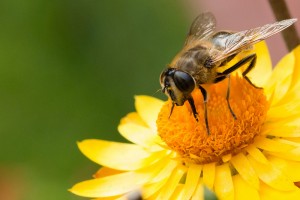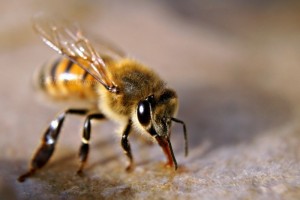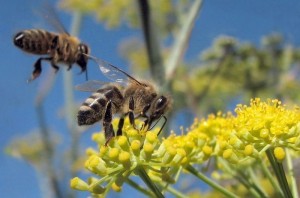Bee Removal | Wasp Removal
Known for their role in pollination and for producing honey and beeswax, bees are flying insects related to wasps and ants. They are in the super family Apoidea which is currently known as the clade Anthophila. There are seven to nine identified bee families and almost 20,000 known bee species. They are found in every habitat in the world that contains insect-pollinated flowering plants and on every continent except Antarctica.
Bees feed on nectar and pollen which are the main sources of their energy and other nutrients. Pollen is mostly used as food for larvae.

Photo credit: Markus Trienke / Foter.com / CC BY-SA
Bees get hold of the nectar from flowers because of their long proboscis (a complex “tongue”). As emblematic for the super family, bees have antennae approximately 13 segments in males and 12 in females. All bees have two pairs of wings; the smaller between the two is the hind pair. None are wingless; however the minority species have quite short wings that make flight difficult or impossible.
Physical Characteristics of bees
Megachile pluto, a leafcutter bee whose females can reach a length of 39 mm (1.5″) is the largest bee in the world. Despite the fact that they are tiny and frequently mistaken for wasps or flies, sweat bees which are members of the family Halictidae are mainly universal type of bee in the Northern Hemisphere.
Bee Diseases
Acarapiosis
Caused by Acarapis woodi, a microscopic mite called the tracheal mite which is an internal parasite of the adult bee’s respiratory system that feeds on hemolymph.
American Foulbrood
This is caused by the Paenibacillus larvae which is a spore forming bacteria. It is a serious disease of honey bees and occurs throughout the world. The bacteria kill the larvae in the brood cell.
European Foulbrood
Caused by the bacteria called Melisococcus plutonius, this bacteria kill the larvae leaving empty cells left in the comb. By mechanical contamination of honeycombs, the disease is being multiplied.

Photo credit: Treesha Duncan / Foter.com / CC BY
Small Hive Beetle Infestation
This is caused by a scavenger and parasite of honey bee colonies called the small hive beetle, Aethina tumida. They feed on pollen, bee brood, larvae, and honey. The adult female lays her eggs in the hive while the larvae hatch and feed on brood, pollen and honey.
Tropilaelaps
These are external parasites that feed on brood (bee larva and pupae). It causes deformities in adults and irregular patterns of sealed and unsealed brood. They multiply by brood’s movement or by direct contact from bee to bee.
Varroosis
This is caused by an external parasite of adults and brood. Varroa destructor is the most vital among the four species of Varroa mites. They are known to spread virus that causes shrunken abdomens for adult bees and deformed wing disease. The disease multiplies by the movement of infested bees and bee brood or by direct contact from bee to adult bee.
Tips to Avoid Bees
Don’t wear perfumes or colognes.
Wearing perfumes or colognes will draw nectar-seeking bees and wasps towards you. Bees can sense and track strong scents. Just when they locate the source of the fragrance, they will draw closer and buzz around you.
Avoid wearing brightly colored clothing, especially floral prints.
Don’t wear bright or floral design clothing. Wearing white, khaki, and beige colors is recommended, especially if you wanted to work on your garden.
Be careful what you eat outdoors.
Always observe if there are bees or wasps around before you eat sweet foods and drinks. Don’t leave your food anywhere.
Don’t walk barefoot.
Always wear shoes or slippers when walking around your lawn. Some wasps build their nest in the ground. They’re going to sting you if you stride on them.
Try not to wear loose-fitting clothes.
Try wearing fitting clothes. Wearing loose clothes might just give bees an easy opening to go on your skin.
Stay still.
Stay calm and take a deep breath once a bee or wasp comes near you. Don’t panic because it’s just trying to find out if you’re a flower or a person.
Keep your car windows rolled up.
If you’re going to drive a car, always keep your car windows closed. Some bees trap themselves in the car and buzz around you. If you do find an unwanted stinging insect in your car, pull over and roll your windows down.
Rinse your garbage and recycling cans and keep lids on them.
Always clean and rinse your trash cans and put tight cover on them to keep bees and wasps away from it. Don’t leave your garbage anywhere.
Don’t hang out in the flower garden.
Don’t spend time in the flower garden. Collecting nectar and pollen from flowers is what bees mostly do. Don’t get in their way or you might just end up being stung.
Call a Bee Removal professional to have unwanted bees, wasps, or hornets removed.
Don’t put yourself at risk for stings. Always call for a professional beekeepers or bee removal experts to resolve insect problems safely. A good wildlife removal company in your area can help you exclude your lawn or homes with bees as they are licensed and certified to do so. Got a bee problem? Call us now at the number below.
Bee Removal – Bee Control
Anytime Wildlife Control
219-464-7966

